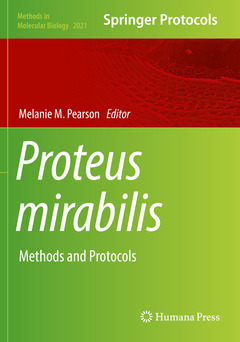Description
Proteus mirabilis, 1st ed. 2019
Methods and Protocols
Methods in Molecular Biology Series, Vol. 2021
Coordinator: Pearson Melanie M.
Language: English
Subject for Proteus mirabilis:
Publication date: 08-2020
342 p. · 17.8x25.4 cm · Paperback
Publication date: 07-2019
342 p. · 17.8x25.4 cm · Hardback
Description
/li>Contents
/li>Comment
/li>
2. Methods for studying swarming/motility
3. Cell culture/adherence/invasion/toxins
4. Urease
5. UTI mouse model: independent and co-challenge
6. CAUTI mouse model
7. Artificial bladder
8. Catheter biofilms/SEM
9. Catheter coatings?
10. LPS analysis (P. mirabilis has at least 79 identified O-serogroups)
11. Mutagenesis/TargeTron
a. attTn7 insertion method12. Dienes lines/ T6SS
13. Fimbriae
a. Culture conditions that favor fimbriation
b. Shear preps
c. Acid preps
d. flow cytometry protocol
14. IVIS protocol
15. Clinical
16. Vaccine protocol
17. Environmental
18. Mathematical models19. Miscellaneous
a. Metals (iron, zinc)
b. Phage
c. Polymyxin resistance
20. Techniques that aren’t particularly exclusive to P. mirabilis/UTI
a. ChIP (PCR and/or seq)
b. RNA isolationc. Microarray analysis
d. Genome sequencing & analysis
e. Biofilm assays
Includes cutting-edge techniques
Provides step-by-step detail essential for reproducible results
Contains key implementation advice from the experts




